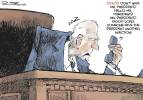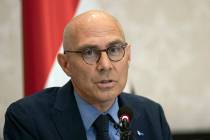Truck drivers seen as crucial during COVID-19 crisis, recovery
Kim Santiago drove slowly along the freeway in Ohio, the needle on the odometer hovering just around 55 mph. His semitrailer can go as fast as 65 mph, but he wouldn’t take that chance.
Not with this delivery.
Packed away in the trailer was a highly flammable load of 40,000 pounds of Purell hand sanitizer, a product that has been in high demand for months because of the COVID-19 pandemic. It was March 30, and Santiago and his driving partner needed to complete the delivery to a Walmart in Texas before the end of the following day.
“That was a pretty crazy experience, actually, because we were nervous carrying that much dangerous material,” Santiago, 27, recalled during a recent interview from his southeast Las Vegas home. “One little crash, and we’d blow up.”
Before that delivery, he had never even seen a truck filled with only hand sanitizer. But he would make an identical delivery to the same Texas Walmart two days later.
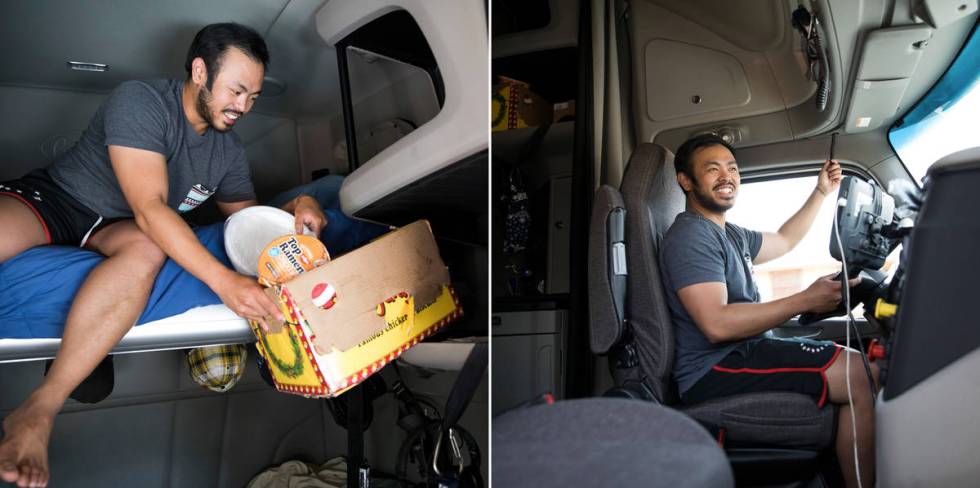
A longtime Las Vegas resident, Santiago began his career as an “over-the-road” truck driver last year, meaning he transports materials over long distances and is typically on the road for weeks — or sometimes even months — at a time. Between early March and mid-May, during the height of the nation’s coronavirus-triggered shutdowns, Santiago lived in the cab of his truck, traveling thousands of miles to complete essential deliveries while most of the country sheltered in place.
The Las Vegas Review-Journal asked Santiago to document his time on the road in a series of video diary entries, offering a glimpse into his round-the-clock efforts to keep shelves stocked across the country amid a global health crisis.
Hailed as unsung heroes of the pandemic, truck drivers like Santiago are now equally essential as the United States shifts from crisis to recovery.
“As crucial as they’ve been in responding to the outbreak and curbing its impact, truckers will be just as pivotal now as we turn toward recovery,” said Chris Spear, president and CEO of American Trucking Associations. “Trucks have kept rolling while the rest of the country stays locked down, and they’ll remain at the forefront when called to power our economy back up.”
Deliveries in nearly 20 states
According to U.S. Bureau of Labor Statistics estimates, Santiago is among more than 1.8 million people in the United States working as heavy truck drivers who handle deliveries weighing at least 26,000 pounds.
“How long does it take to empty the shelves?” said Keith Parry, a local driving instructor who, before teaching, worked as a truck driver for more than 30 years. “If truck drivers didn’t make deliveries, the entire town would shut down in a matter of one or two days.”
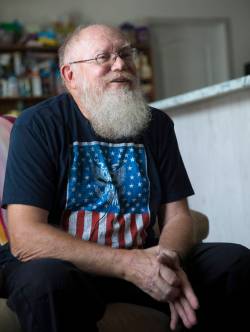
To curb shortages around the country sparked by the pandemic, the Federal Motor Carrier Safety Administration in March declared a nationwide emergency.
The declaration, which has been extended until mid-June, eased driving hours for truck drivers transporting essential goods such as medical supplies, COVID-19 testing kits, sanitation supplies and food. Typically, a driver can’t exceed 11 consecutive driving hours during a 14-hour work day.
During the shutdown, Santiago and his partner, a Southern California resident who declined to participate in this story, took turns driving between 12 and 14 hours in order to meet their deadlines. The two met during a work orientation and quickly became friends. They have been driving together ever since.
From March to May, the pair made deliveries to nearly 20 states and dozens of cities, oftentimes driving back and forth between destinations to complete multiple assignments. Their loads varied but included sanitary supplies, such as the 40,000 pounds of hand sanitizer, and protective equipment, such as a delivery in late April of 156,000 masks.
They traveled as far east as New Jersey, a hot spot for the virus, and south to Mississippi and Alabama. Oregon was Santiago’s favorite state. He liked the greenery.

A hard job
Essential workers long before the novel coronavirus upended life, Parry said, truck drivers normally go unnoticed. They work quietly behind the scenes.
“It’s not as easy a job as you might think,” he told the Review-Journal.
For some drivers, like Santiago, the work keeps them away from their families and the comfort of their homes for extended periods of time. It’s a job not without sacrifice.
After working through the height of the shutdown, Santiago, who is close to his parents and three siblings, finally got to come home for five days in mid-May.
Trucks have kept rolling while the rest of the country stays locked down, and they’ll remain at the forefront when called to power our economy back up.
Chris Spear, president and CEO of American Trucking Associations
“I miss my friends, my family, my bed,” he said in a video diary he recorded in early May while stopped for gas. “Sleeping on the road’s rough, but I got to do it.”
With strict delivery deadlines and social distancing measures at play, he and his partner rarely left their truck. They ate inside it, slept inside it, took breaks from driving inside it. In three months, they treated themselves to a motel room only once.

Their white Peterbilt truck has a sleeper area just behind the driver’s seat. It’s a modest setup: two beds, each smaller than the average twin-sized mattress, stacked on top of one another. A bunk bed, essentially. For privacy, there’s a black curtain to separate the sleeping area from the cab of the truck.
Santiago claimed the top bunk. He feels like a monkey, or a child on a playground, whenever he climbs up to his bunk. There’s no ladder, so he places his feet on top of small edges or on the mini-fridge to get up there.
The beds feel more like a cross between a mattress and an exercise mat, like something you’d find on the floor of a gymnastics studio, or maybe sprawled out in your high school gymnasium.
Near his bed, Santiago keeps a bottle of melatonin supplements to help him sleep. Between the uncomfortable mattress and constant movement of the truck, it’s difficult to get any rest, he said.

Life on the road
The pandemic didn’t change too much about his daily work routine, he said, other than having to wear gloves and a mask any time he left his truck.
Maybe that’s because even in the absence of a global health crisis, life on the road doesn’t really feel like living, Santiago said. You’re either driving, sleeping, eating bad food or trying to pass the time until it’s your turn to drive again.
And it’s difficult to keep the weight off.
There are some days where I just don’t want to be driving, you know what I mean? I drive about 14 hours a day, and that’s every day, so it’s not like I get to come home.
Kim Santiago
Taped to the panel above the driver’s seat is a small white piece of paper. On it, with a black marker, Santiago wrote: “EVERYDAY! 3x10 curls, 3x10 presses, 50 pushups. EASY!”
Next to the driver’s seat are two dumbbells, one weighing 8 pounds and the other 25 pounds. In an overhead compartment, he also keeps a jump-rope, an ab roller and some resistance bands — to use during the rare times they are stopped.
Still, Santiago said as he patted his belly, he returned to Las Vegas around 10 pounds heavier.
His next assignment will keep him and his driving partner on the road for a month.
“There are some days where I just don’t want to be driving, you know what I mean? I drive about 14 hours a day, and that’s every day, so it’s not like I get to come home,” he said. “It’s the sacrifice I have to make for myself. But I’m truly blessed that I am still able to work.”
Each time he leaves, it gets harder to say goodbye to his family, but he chose a career in long-haul driving over local deliveries because of the pay.
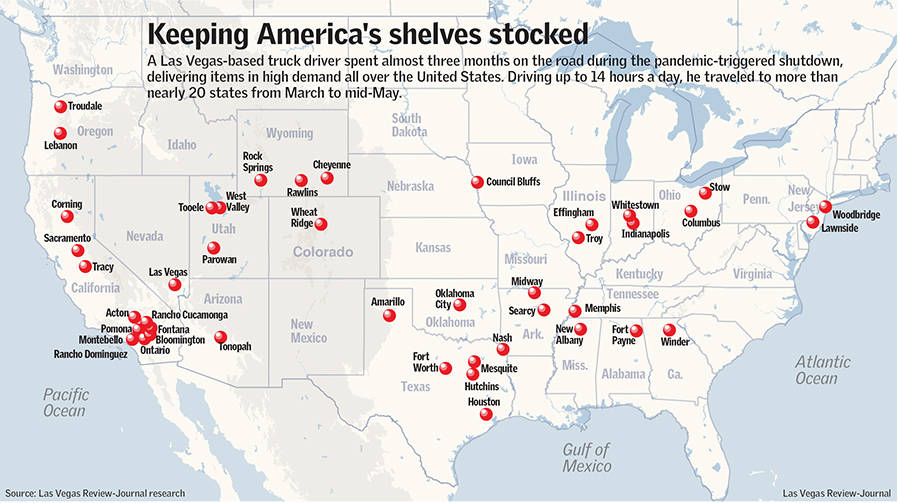
“How you get paid is by the miles you drive,” he said.
Shoving clothes into his bag on May 19, Santiago prepared to wake up early the next morning, climb into his truck, and drive to the first destination of his next journey: Barstow, California.
Contact Rio Lacanlale at rlacanlale@reviewjournal.com or 702-383-0381. Follow @riolacanlale on Twitter.









